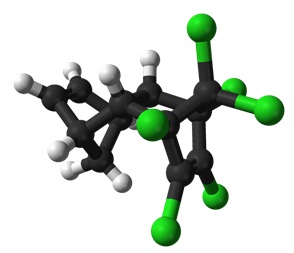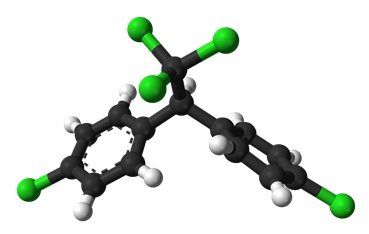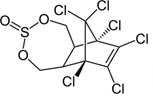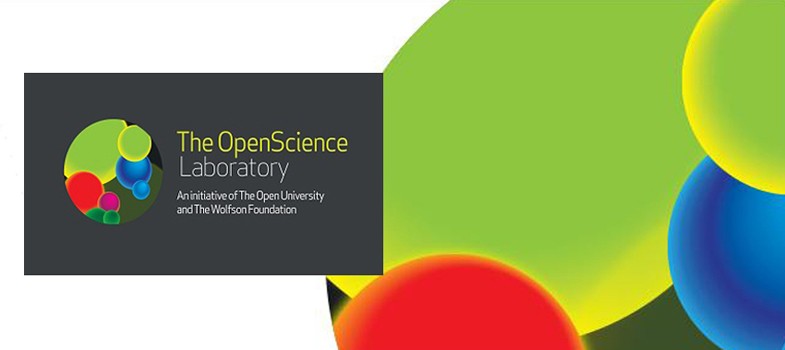5 The chemical structure of pesticides continued
Some of the structures in Table 1 also convey the 3D nature of the molecules. Solid wedges represent bonds pointing towards you out of the paper and dashed wedges represent bonds pointing away from you below the paper. Look at the 3D structure of Aldrin in Figure 4 and compare it with the structure in Table 1. Can you see that the green balls are the chlorine atoms, the black balls are carbon atoms, and the white balls are hydrogen atoms?

We can work out the molecular formulas for the pesticides by counting the atoms in the structures. For example in DDT (third row in Table 1) we can count 14 carbon atoms (14 junctions between bonds. To count the hydrogen atoms, which are not shown in these structural formulas, the valency of carbon is important.
What is the valency of carbon?
Answer
Carbon is in group 4 of the periodic table so has valency 4.
Each carbon atom must have four bonds, to match the valency. In DDT the carbon atoms bonded with any of the chlorine atoms already have four bonds but some of the other carbons atoms only have three – there must be a ‘missing’ hydrogen atom here. Counting these gives nine hydrogen atoms. The molecular formula for DDT is therefore C14H9Cl5. To help confirm this, the 3D structure of DDT is shown in Figure 5.

- Following this example, work out each of the molecular formulas that are missing in the table.
| Pesticide | Molecular formula | Structure | Information Footnotes a |
| Aldrin | C12H8Cl6 |  | pesticide (banned but restricted use as a local insecticide) |
| Dieldrin | C12H8Cl6O |  | insecticide (banned but restricted use for agricultural purposes) |
| Dichlorodiphenyltrichloroethane (DDT) |  | pesticide (banned but restricted use for malaria control) | |
| Endosulfan | C9H6Cl6O3S |  | insecticide (banned only recently, still in use in China and India) |
| Endrin | C12H8Cl6O |  | insecticide and rodenticide (banned) |
| Hexachlorocyclohexane (αHCH) |  | pesticide (banned) | |
| Lindane (γ-HCH) | C6H6Cl6 |  | insecticide (banned but restricted pharmaceutical use for treatment of lice and scabies) |
| Heptachlor |  | insecticide (banned but restricted use use as a termiticide) | |
| Methoxychlor |  | insecticide (banned in US and EU) | |
| Pentachloronitrobenzene (PCNB) | C6Cl5NO2 |  | fungicide |
Footnotes
Footnotes a Banned status according to the United Nations Treaty (known as the Stockholm Convention on Persistent Organic Pollutants), which has been signed by the majority of countries. One notable exception is the USA, which has its own list of banned substances covering many of the same pesticides.4 The chemical structure of pesticides
